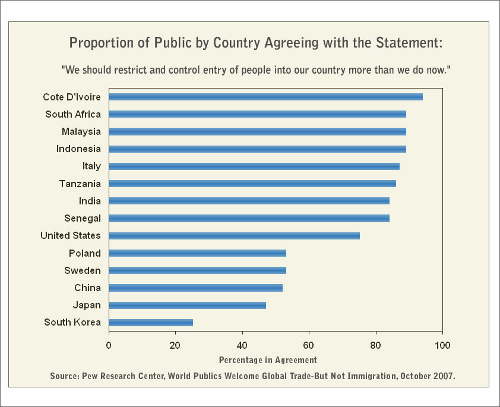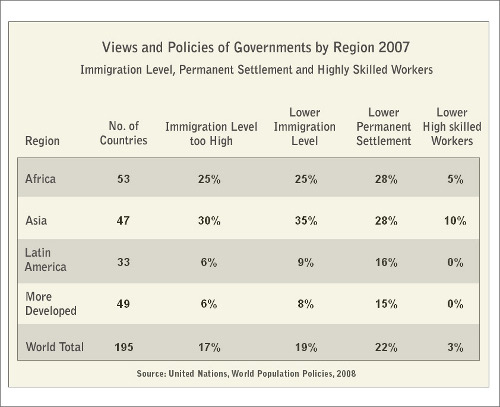Despite the known reluctance of the overwhelming majority of people in most countries to let in immigrants, governments continue to promote policies that maintain or increase immigration levels. This thorny gap between public opinion and government policies on immigration is leading increasingly to social unrest, political upheaval and in some instances even violence.
Whether in affluent countries in the West or less wealthy nations in the developing world, people are concerned about immigration. In addition to unemployment and economic uncertainties, people are worried about losing their traditional culture and national identities; they feel that their way of life is being badly affected and needs protection from the adverse effects of foreign influences. Opinion polls regularly report that large majorities believe that there should be greater restriction of immigration and tighter control of their country's borders.
A global study of public attitudes by the Pew Center in 2007, for example, found that the majority of the people in 44 of the 47 countries surveyed agree with the statement: “We should restrict and control entry of people into our country more than we do now” (Figure 1). With the exception of a few low-immigration countries, i.e., Japan and South Korea, majorities in every country surveyed said that their countries should restrict immigration and control the entry of people more than they do now.
Advertisement

Figure 1. Public opinion on immigration.
This view is especially widespread in Africa and Asia, where at least 75 per cent of the public polled felt that immigration should be more restricted and controlled. Majorities wishing for increased restrictions on immigration were also prevalent throughout countries in North and South America. Similar sentiments were shared by the greater part of the populations in Europe, even in countries facing population decline and ageing, such as Italy and Russia.
In fact, Italy led Europe with nearly 90 per cent of the Italians agreeing that their country should restrict and control the entry of people more than it does today. As it is the landing-point in Europe for many migrants from Africa, the number of immigrants in Italy - currently 4 million - grew faster during recent years than in any other European country. Also last year, Italy experienced a 75 per cent leap in unauthorised migrants arriving by sea to more than 37,000.
In sharp contrast with public opinion, few governments view their immigration levels as too high (Table 1). Among more developed countries, for example, 6 per cent of the governments viewed their immigration as too high and 8 per cent reported governmental policies to lower immigration.

Advertisement
Table 1. Governments' views on immigration.
In addition, whereas a handful of countries had policies to lower immigration for permanent settlement, not a single developed nation had policies to lower the immigration of highly skilled workers. On the contrary, most developed countries are competing globally to recruit and retain talented highly skilled workers, such as scientists, doctors, nurses, teachers and high-tech personnel.
For example, the United Kingdom expanded economic immigration with visas for highly skilled economic immigrants to enter the country without a job offer, but simply on the basis of their skills. Some European countries, such as Germany and the Netherlands, have instituted fast-track visas and “Green Card” systems, similar to the US, to attract highly skilled migrants, especially IT specialists. In the United States even local school districts have turned increasingly to overseas recruiting to find skilled teachers: for example, teachers recruited from the Philippines are reported to make up more than 10 per cent of the teaching force in the Baltimore Public Schools.
Discuss in our Forums
See what other readers are saying about this article!
Click here to read & post comments.
7 posts so far.